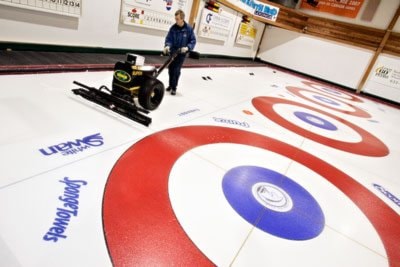The best thing about throwing rocks at the Whitehorse Curling Club is that disgruntled curlers can’t blame the ice.
“It’s very consistent — it’s some of the best ice you’ll play on anywhere around the world in the whole curling season,” said Chris Schille from the Schille Team who won last weekend’s Skookum Cash Spiel.
“The speed stays the same. It’s just very easy as a player to know what the rocks are going to do after you throw them; there’s no guesswork at all. It’s really just perfect ice.”
For the curling club’s head ice technician, Doug Gee, producing and maintaining the top-notch ice is a labour of love — he begins every day by scraping and pebbling the sheets.
An avid curler since the age of 15, Gee was looking for a way to get more involved in the sport, and the logical move for him was getting into ice.
“I was looking for a way to be involved in the game all the time, so icemaking was a natural process for it,” said Gee. “Then I started really liking making ice.”
As an ice technician, Gee has helped prepare ice at the Brier in 2006, the Scotties Tournament of Hearts in 2004 and will be going to the Scotties again next year at the end of February.
Perhaps best of all for Gee, he gets to experience the benefits of his hard work and expertise, playing twice a week in the Super League on Tuesdays and the Open League on Thursdays.
In fact, he should know what good ice is like to curl on — last year Gee went to the Briar as a fifth for Chad Cowan’s team and played in a game against Nova Scotia.
Preparing the ice for the season is a long and expensive process. Gee begins by coating the concrete floor with a thin layer of ice by spraying it with a mist of water. Then comes a series of five floodings, each time adding a layer of ice about an eighth of an inch think. The hacks, which are like starting blocks that the curlers push off of, are then installed with the pins for the houses.
Surprisingly, the ice is not what provides the pristine white surface, but instead a thin layer of white paint that is sealed in with another thin layer of ice.
“If you just put water on (the floor) it would look like grey concrete,” said Gee. “It’s even more so because the ice magnifies everything that’s under it.”
Using a long bar with a series of four routers on it, like a compass in math class, Gee stabilizes one end in the centre of the button and rotates the other around it to cut the three rings into the ice, which are then painted along with the hog lines.
After another flooding come the lines. They are not painted, instead they are strung with ordinary wool.
“All those lines are the same that you would buy at Wal-Mart,” said Gee.
Another spraying and flooding is completed before the sponsors’ logos are placed on the ice. Once again spraying and flooding, the ice is then ready for the final stage, scraping and adding pebbles, the little bumps on the surface that the rocks slide upon. The scraping is absolutely necessary because ice will freeze level, but not always flat.
“It’s got what they call floodlines, little waves,” said Gee. “So you have to scrape until it’s completely flat.”
The entire process, including power, water and man-hours, costs the club roughly $30,000 from start to finish.
Although Gee experiments a lot with the icemaking process and ice maintenance, he claims there are no secret procedures.
“There’s no secrets out there,” said Gee. “My techniques are just about the same as the top-level icemakers in Canada … Every building is a little bit different, so you have to adjust a little bit.”
Gee didn’t watch a how-to video to learn the process, he studied his trade under some of the country’s premier icemakers. However, he does experiment with ice temperatures, different pebbles and even the direction and patterns in which he scraps the ice.
“I’m always trying something different,” said Gee. “I’m pretty lucky that the curlers put up with it.”
Since he began working Whitehorse’s ice in January 1997, the club has purchased a reverse osmosis machine to provide Gee with purified water for the ice.
“It’s real common nowadays,” said Gee. “In the last, I’d say, 15 years, every curling rink has gone to purified water.”
The purified water is better because in the process of freezing unfiltered water impurities float to the top, causing the pebbles to break down quicker and getting curlers’ pant legs dirty.
On top of that, since purified water has a lower freezing temperature, it’s cheaper in terms of the power bills.
“The biggest expense (to the club) is the power,” said Gee. “I think our average power bill is $7,000 a month — I think we just got one for $8,000.”
Gee takes a moment to consider things when asked why he thinks his ice is so highly esteemed among curlers. Being the humble man he is, he first points to the club.
“Because the club has gone out and got the proper equipment, to make sure I can do what I want to do out there — they’ve got the good scraper, the reverse osmosis filter, any pebble heads or anything like that that I want,” said Gee. “They get it for me. They don’t back off on any of that stuff.
“It’s experience (and) I had some very good teachers,” continued Gee. “You learn after a while — you play around with the stuff. You just see what works.”
Contact Tom Patrick at
tomp@yukon-news.com
